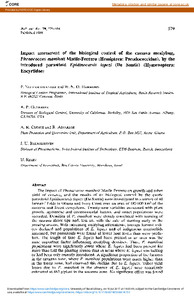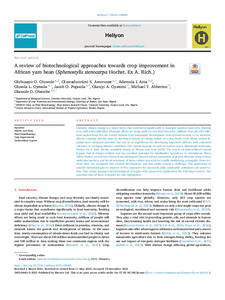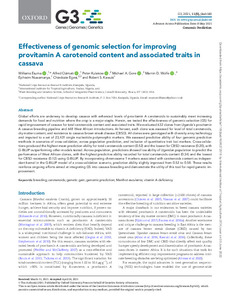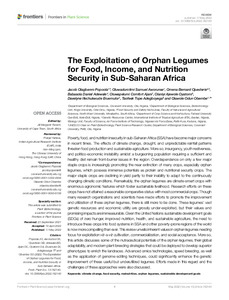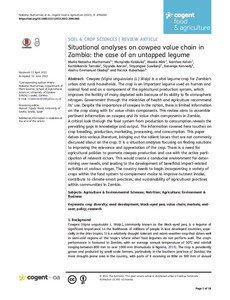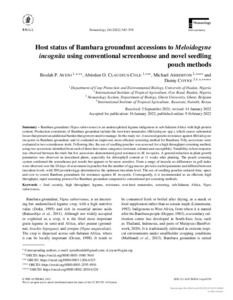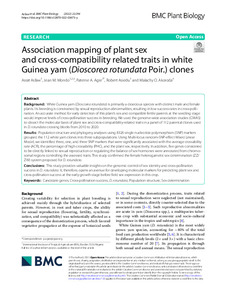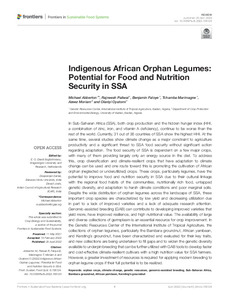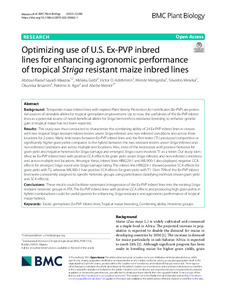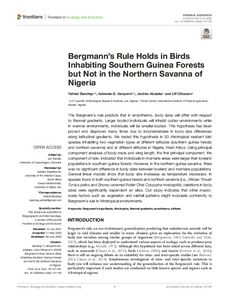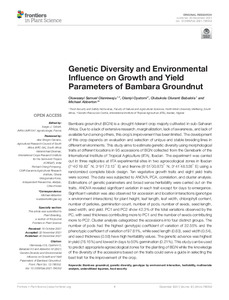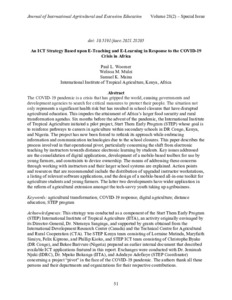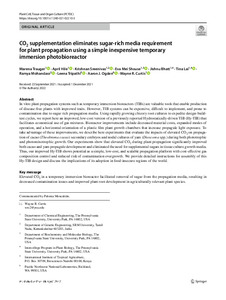Welcome to the International Institute of Tropical Agriculture Research Repository
Journal and Journal Articles: Recent submissions
Now showing items 641-660 of 5157
-
Impact assessment of the biological control of the cassava mealybug, Phenacoccus manihoti Matile-Ferrero (Hemiptera: Pseudococcidae), by the introduced parasitoid Epidinocarsis lopezi (De Santis)(Hymenoptera: Encyrtidae)
(1989)The impact of Phenacoccus manihoti Matile-Ferrero on growth and tuber yield of cassava, and the results of its biological control by the exotic parasitoid Epidinocarsis lopezi (De Santis) were investigated in a survey of 60 farmers' fields in Ghana and Ivory Coast over an area of 180 000 km2 of the savana and forest ecosystems. Twenty-nine variables associated with plant growth, agronomic and environmental factors, and insect populations were recorded. Densities of P. manihoti were closely correlated ... -
A review of biotechnological approaches towards crop improvement in African yam bean (Sphenostylis stenocarpa Hochst. Ex A. Rich.)
(2021-11)Globally, climate change is a major factor that contributes significantly to food and nutrition insecurity, limiting crop yield and availability. Although efforts are being made to curb food insecurity, millions of people still suffer from malnutrition. For the United Nations (UN) Sustainable Development Goal of Food Security to be achieved, diverse cropping systems must be developed instead of relying mainly on a few staple crops. Many orphan legumes have untapped potential that can be of ... -
Effectiveness of genomic selection for improving provitamin A carotenoid content and associated traits in cassava
(2021-09)Global efforts are underway to develop cassava with enhanced levels of provitamin A carotenoids to sustainably meet increasing demands for food and nutrition where the crop is a major staple. Herein, we tested the effectiveness of genomic selection (GS) for rapid improvement of cassava for total carotenoids content and associated traits. We evaluated 632 clones from Uganda’s provitamin A cassava breeding pipeline and 648 West African introductions. At harvest, each clone was assessed for level of ... -
The exploitation of orphan legumes for food, income, and nutrition security in sub-Saharan Africa
(2022)Poverty, food, and nutrition insecurity in sub-Saharan Africa (SSA) have become major concerns in recent times. The effects of climate change, drought, and unpredictable rainfall patterns threaten food production and sustainable agriculture. More so, insurgency, youth restiveness, and politico-economic instability amidst a burgeoning population requiring a sufficient and healthy diet remain front-burner issues in the region. Overdependence on only a few major staple crops is increasingly promoting ... -
Arbuscular mycorrhizal fungi community composition, richness and diversity on enset (Ensete ventricosum (Welw.) Cheesman) in Ethiopia is influenced by manure application intensity in low‑input farming systems
(2022)Aims In low-input agricultural systems, arbuscular mycorrhizal fungi (AMF) play a role in plant nutrition, protection and water use. Evaluating how agricultural practices affect the composition of AMF communities is therefore an important step towards sustainable intensification. We characterized the AMF communities in enset (Ensete ventricosum) roots in smallholder enset-based farming systems in south Ethiopia and assessed the effects of soil fertility management on those communities. Methods We ... -
Situational analyses on cowpea value chain in Zambia: the case of an untapped legume
(2022-07-05)Cowpea (Vigna unguiculata (L.) Walp) is a vital legume crop for Zambia’s urban and rural households. The crop is an important legume used as human and animal food and as a component of the agricultural production system, which improves the fertility of many depleted soils because of its ability to fix atmospheric nitrogen. Government through the ministries of health and agriculture recommend its’ use. Despite the importance of cowpea in the nation, there is limited information on the crop along ... -
Host status of Bambara groundnut accessions to Meloidogyne incognita using conventional screenhouse and novel seedling pouch methods
(2022-02-09)Bambara groundnut (Vigna subterranea) is an underexploited legume indigenous to sub-Saharan Africa with high protein content. Production constraints of Bambara groundnut include the root-knot nematodes (Meloidogyne spp.), which causes substantial losses that present an additional burden that growers need to manage. In this study we: i) assessed genetic resistance against Meloidogyne incognita in Bambara groundnut; and ii) evaluated an improved, more efficient screening method for Bambara. Fifty ... -
Integrated management of Spodoptera frugiperda 6 years post detection in Africa: a review
(2022-08)The introduction of fall armyworm (FAW) Spodoptera frugiperda (JE Smith) (Lepidoptera: Noctuidae) on the African continent has led to paradigm shifts in pest control in maize systems, occasioned by year-round populations. The discovery of resident parasitoid species adapting to the new pest significantly informed decision-making toward avoiding highly hazardous synthetic insecticides to control the pest. A number of biopesticides have shown promise against the fall armyworm, providing a new arsenal ... -
Assessing the fodder potentials of drought-tolerant maize (Zea mays L.) hybrids in west Africa
(2022)The study evaluated the fodder potential of 42 promising drought-tolerant (DT) three-way cross maize (Zea mays L.) hybrids, 11 commercial hybrid checks, and 1 local variety check under irrigation. Agronomic and laboratory trials were conducted to determine their morphological traits and fodder potential. Hierarchical cluster analysis (HCA) to group cultivars into clusters is based on quantity, quality, and the combination of both variables. Selection of potential food-feed cultivars was based on ... -
Sustainable management of transboundary pests requires holistic and inclusive solutions
(2022-06-06)Globalization and changing climates are aggravating the occurrence and impacts of transboundary pests, and driving the emergence of new threats. Most of the low- and middle-income countries in Africa, Asia and Latin America are not fully prepared in terms of surveillance, diagnostics, and deployment of plant health solutions due to several factors: adequate investment is lacking; knowledge is inadequate; and connections from the local to global, and global to local are insufficient. Effectively ... -
Association mapping of plant sex and cross-compatibility related traits in white Guinea yam (Dioscorea rotundata Poir.) clones
(2022-06-15)Background White Guinea yam (Dioscorea rotundata) is primarily a dioecious species with distinct male and female plants. Its breeding is constrained by sexual reproduction abnormalities, resulting in low success rates in cross-pollination. An accurate method for early detection of this plant’s sex and compatible fertile parents at the seedling stage would improve levels of cross-pollination success in breeding. We used the genome-wide association studies (GWAS) to dissect the molecular basis of ... -
Indigenous African orphan legumes: potential for food and nutrition security in SSA
(2022)In Sub-Saharan Africa (SSA), both crop production and the hidden hunger index (HHI, a combination of zinc, iron, and vitamin A deficiency), continue to be worse than the rest of the world. Currently, 31 out of 36 countries of SSA show the highest HHI. At the same time, several studies show climate change as a major constraint to agriculture productivity and a significant threat to SSA food security without significant action regarding adaptation. The food security of SSA is dependent on a few major ... -
Inheritance of resistance to three endemic viral diseases of cowpea in Nigeria
(2022-06-22)Mosaic diseases, caused by bean common mosaic virus-blackeye cowpea mosaic strain (BCMV-BlCM), southern bean mosaic virus (SBMV), and cucumber mosaic virus (CMV), hamper the productivity of cowpea (Vigna unguiculata (L.) Walp.). Under single or mixed infections, these endemic viruses significantly reduce cowpea yield in sub-Saharan Africa. Planting resistant varieties is the most effective control method. Knowledge of the mode of inheritance of viral resistance is crucial in developing resistant ... -
"Stop calling me a youth!": Understanding and analysing heterogeneity among Ugandan youth Agripreneurs
(2022-06-12)The African “youth” population is growing at a fast and steady pace, attracting attention from scholars, policymakers, and politicians. Yet, we know relatively little about this large and heterogeneous segment of the population. This paper presents data from 110 interviews and ten focus groups with youth engaged in commercial agriculture across all four regions of Uganda. Capitalising on this ethnographic data, we provide an analytical framework for studying complexity among the heterogeneous ... -
Optimizing use of U.S. Ex-PVP inbred lines for enhancing agronomic performance of tropical Striga resistant maize inbred lines
(2022-06-10)Background Temperate maize inbred lines with expired Plant Variety Protection Act certificates (Ex-PVP) are potential sources of desirable alleles for tropical germplasm improvement. Up to now, the usefulness of the Ex-PVP inbred lines as a potential source of novel beneficial alleles for Striga hermonthica resistance breeding to enhance genetic gain in tropical maize has not been reported. Results This study was thus conducted to characterize the combining ability of 24 Ex-PVP inbred lines ... -
Bergmann's rule holds in birds inhabiting southern Guinea forests but not in the northern Savanna of Nigeria
(2022)The Bergmann’s rule predicts that in endotherms, body sizes will differ with respect to thermal gradients. Larger bodied individuals will inhabit colder environments while in warmer environments, individuals will be smaller-bodied. This hypothesis has been proved and disproved many times due to inconsistencies in body size differences along latitudinal gradients. We tested this hypothesis in 30 Afrotropical resident bird species inhabiting two vegetation types at different latitudes (southern ... -
Genetic Diversity and Environmental Influence on Growth and Yield Parameters of Bambara Groundnut
(2021-12-20)Bambara groundnut (BGN) is a drought-tolerant crop majorly cultivated in sub-Saharan Africa. Due to a lack of extensive research, marginalization, lack of awareness, and lack of available fund among others, this crop’s improvement has been limited. The development of this crop depends on evaluation and selection of unique and stable breeding lines in different environments. This study aims to estimate genetic diversity using morphological traits at different locations in 95 accessions of BGN ... -
Indifferent to difference? Understanding the unequal impacts of farming technologies among smallholders. A review
(2022)With many of the world’s poor engaged in agriculture, agricultural development programmes often aim to improve livelihoods through improved farming practices. Research on the impacts of agricultural technology interventions is dominated by comparisons of adopters and non-adopters. By contrast, in this literature study, we critically review how technology evaluation studies assess differentiated impacts in smallholder farming communities. We searched systematically for studies which present ... -
An ICT strategy based upon E-Teaching and E-Learning in response to the COVID-19 crisis in Africa
(2021)The COVID-19 pandemic is a crisis that has gripped the world, causing governments and development agencies to search for critical measures to protect their people. The situation not only represents a significant health risk but has resulted in school closures that have disrupted agricultural education. This impedes the attainment of Africa’s larger food security and rural transformation agendas. Six months before the advent of the pandemic, the International Institute of Tropical Agriculture ... -
CO2 supplementation eliminates sugar-rich media requirement for plant propagation using a simple inexpensive temporary immersion photobioreactor
(2022)In vitro plant propagation systems such as temporary immersion bioreactors (TIBs) are valuable tools that enable production of disease-free plants with improved traits. However, TIB systems can be expensive, difficult to implement, and prone to contamination due to sugar rich propagation media. Using rapidly growing chicory root cultures to expedite design-build-test cycles, we report here an improved, low-cost version of a previously reported Hydrostatically-driven TIB (Hy-TIB) that facilitates ...

